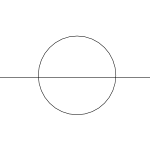Feynman Graphs and Motives
Wednesday, March 20th, 2013 | Author: Konrad Voelkel
Being on a school about Feynman graphs and Motives, I just learned how these are related. It's a cute story! Actually, you don't need any physics to appreciate it, though physics might let you appreciate it even more.
A Feynman graph is just a (non-directed) graph with a finite number of vertices and a finite number of edges. Physicists are interested in computing certain integrals defined in terms of Feynman graphs, which they call amplitudes.
To a graph one can associate the graph polynomial which is defined as a sum over all spanning trees. A tree is a subgraph which is 1-connected (connected and without loops) and a spanning tree is a tree which meets every vertex. Consider the polynomial ring over the integers with one polynomial variable for each edge of the graph. Then, for a spanning tree, take the product over all variables that correspond to edged not in the tree. Sum these over all spanning trees and you get the graph polynomial. This is also called Kirchhoff polynomial, since it was discovered by Kirchhoff in work on electric circuits. Minor caveat: whereas the classical Kirchhoff polynomial of a disconnected graph should be 0, the graph polynomial should be defined as the product of the Kirchhoff polynomial of the connected components.
With a polynomial comes an affine variety, i.e. the zero-set of the polynomial. In general, this variety will be highly singular. Nevertheless, we can assign a motive (in Voevodsky's category DM) to this variety.
Now one can analyze whether these motives are of a special kind, which periods they give (the amplitudes mentioned above are actually periods) and so on. Since many small graphs give multiple zeta values as periods, there was the conjecture floating around (by Kontsevich) that Feynman motives (=motives coming from Feynman graphs) are Tate motives (because that would explain the MZVs appearing as periods). But that's not true in general, by a result of Belkale and Brosnan. What can be said about these motives and these periods? It seems to be unknown, right now.
My questions would be: How large is the tensor-category generated by Feynman motives (as subcategory of DM)? It certainly is larger than Tate motives (though I don't even know whether it contains all Tate motives, but other people probably know that). Can one still hope to find a t-structure that cuts out Feynman motives? Would that give a Tannakian category? Probably the graph motives are just not a very "motivic" subcategory, so there is no good answer to these questions. Since the periods appear to be rather special (and close to MZVs), these questions are still of interest.
Instead of telling you more about this story, I send you to these interesting papers (in which I hope to read more this week):
- Spencer Bloch, Hélène Esnault, Dirk Kreimer: On motives associated to graph polynomials, the paper that started the story.
- Christian Bogner, Stefan Weinzierl: Feynman graph polynomials gives an easy introduction to graph polynomials, spanning trees and matroids.
- Dominique Manchon: Hopf algebras, from basics to applications to renormalization tells you how these Feynman graphs form a Hopf algebra (and what a Hopf algebra is).
- Prakash Belkale, Patrick Brosnan: Matroids, motives and conjecture of Kontsevich shows that Kontsevich's conjecture was wrong, by demonstrating that graph polynomials generate the Grothendieck ring of counting functions.
- Stefan Müller-Stach, Benjamin Westrich: Motives of graph hypersurfaces with torus operations analyzes what one can say about Feynman motives which admit a torus operation.
